
Melicytus ramiflorus is a small tree of the family Violaceae endemic to New Zealand.

Austramathes is a genus of moths of the family Noctuidae. It is endemic to New Zealand.

Melicytus lanceolatus, commonly called narrow-leaved māhoe or māhoe-wao, is a small tree of the family Violaceae endemic to New Zealand.

Ichneutica maya is a moth of the family Noctuidae. It is endemic to New Zealand. It is found in the mountains in southern half of the North Island and in the South Island. I. maya is a distinctively coloured and patterned moth and as such is unlikely to be confused with similar species. I. maya can be found in the southern half of the North Island down through the South Island. This species can be found in alpine to subalpine zones with high rainfall but in Southland this species can be found down to sea level. This life history in the wild is unknown, nor has its larval host species been confirmed. Adults are on the wing from December to March and are attracted to sugar and light traps.
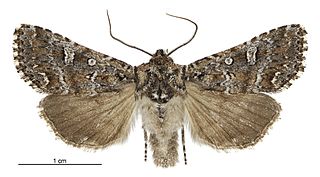
Ichneutica lithias is a moth of the family Noctuidae. This species is endemic to New Zealand. It is a small moth but distinctive as a result of the markings on its forewings. Although this species is widespread in the South Island, it has only been collected in the Rangipo Desert in the North Island. The species prefers habitat that is scrubland ranging in altitude from coastal to alpine. Adults are on the wing from October to April and larvae have been collected and reared on the New Zealand endemic plant species Melicytus alpinus.
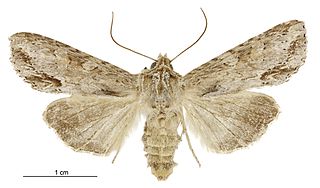
Ichneutica mollis is a moth of the family Noctuidae. It is endemic to New Zealand and is found from the Coromandel peninsular and Mount Te Aroha southwards including in the South and Stewart Islands. It lives in a variety of habitats including mountainous beech forest, podocarp forest and also grasslands. The larvae feed on grasses and herbs. The adults of this species are on the wing from October to March and are attracted to light and feed on blossoms.

Ichneutica olivea is a moth of the family Noctuidae. It is endemic to New Zealand and is found in the central North Island down to the central South Island. It is very similar in appearance to I. lindsayorum but has a shorter basal streak and has white scaling from the subterminal line on the forewings that I. lindsayorum lacks This species prefers shrubland habitat. The life history of I. olivea is unknown as are the host species of its larvae. The adults are on the wing from December to March and are attracted to light.

Ichneutica petrograpta is a moth of the family Noctuidae. This species is endemic to New Zealand where it is found in the southwest districts of the South Island, including Westland, Otago Lakes and Fiordland. It is very similar in appearance to I. mutans. It inhabits tussock and shrubland in the alpine to subalpine zones. Adults of I. petrograpta are on the wing from December to February and are attracted to sugar traps. The life history of this species is unknown as are the host species of its larvae.
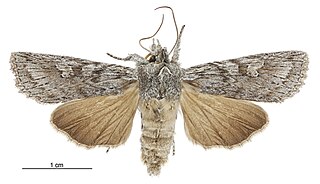
Physetica phricias is a moth of the family Noctuidae. It is endemic to New Zealand. It is wide spread in the South Island and inhabits shrubland. The host of the larvae of this species is matagouri. The adult moths are on the wing from September to May and July.

Ichneutica blenheimensis is a species of moth in the family Noctuidae. It is endemic to New Zealand and is found throughout the North, South and the Stewart Islands. This species appears to prefer drier eastern localities and is rarely collected in western North Island forested areas. It does not appear to be frequently collected in inland dry tussock grassland habitats. The host plant for the larvae of this species is likely to be the golden sand sedge pīngao which is now absent from the moths type locality. However Chappell has raised very young larvae on grass species and the more developed larvae consumed Phormium tenax. Adults are on the wing from November to March and are attracted to both light and sugar traps. The blackish forewing fringes are diagnostic of this species. But worn specimens of I. arotis can be confused with worn specimens of I. blenheimensis. However I. arotis can be distinguished from I. blenheimensis as it has a scale-tuft on the thorax and dark longitudinal stripes on the tegula. This species is classified as "At Risk, Naturally Uncommon" by the Department of Conservation.

Ichneutica paraxysta is a moth of the family Noctuidae. It is endemic to New Zealand. This species is very similar in appearance to its close relative I. acontistis but as the range of the two species do not overlap this is unlikely to cause confusion. I. paraxysta is only found in the North Island at the subalpine zones in the Mount Taranaki region and at Mount Ruapehu. It prefers tussock grassland and shrubland habitat. The life history of this species is unknown as are the host species of its larvae however it has been hypothesised that the larval host plants are species in the genera of Poa and Festuca.

Austramathes purpurea is a species of moth in the family Noctuidae. It is endemic to New Zealand and can be found throughout the North and South Islands but has yet to be recorded at Stewart Island. It inhabits native forest. This species might possibly be confused with A. pessota, however this latter species does not have the purple hue to the forewings. The larvae of A. purpurea feed primarily on māhoe but have been recorded as feeding on, and have been reared on, narrow-leaved māhoe. The larvae pupate in a silken cocoon on moss covered ground. Adults can be found on the wing during the months of March to January but mainly occur during New Zealand's late autumn, winter, and spring. Light trapping may not be the most efficient technique for collecting this species.

Ichneutica cuneata is a moth in the family Noctuidae. It is endemic to New Zealand. I. cuneata is found in and around the Tongariro National Park in the North Island and throughout the South Island. Specimens found in Tongariro National Park tend to be darker in appearance than South Island specimens but as their colour is variable, and antennae and genitalia of both species are consistent, they are not now regarded as a separate species. I. cuneata inhabits tussock grasslands and shrublands in alpine and subalpine zones. The adults are on the wing from December to April and can be found flying during the day. The life history of I. cuneata is unknown as are the specific host species of its larvae. However larvae of I. cuneata are said to feed on herbaceous plants. The adults of this species also pollinate native species such as Myosotis macrantha.
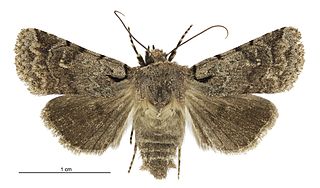
Austramathes fortis is a species of moth in the family Noctuidae. It is endemic to New Zealand and is found in both the North and the South Islands but has yet to be recorded at Stewart Island. It can be found in shrubland containing its host species at a range of altitudes from sea-level up to 1840 m. The larvae of this moth feed on several Melicytus species including M. crassifolius, M. alpinus, M. macrophyllus and M. novae-zelandiae. The larvae pupate in a cocoon of silk at the base of its host plant. It can take between 25 and 45 days before the adult moth emerges. Adults can be found on the wing during the months of July to March. The adults tend to be on the wing in twilight hours but have also been known to be active during the late afternoon. They are attracted to light but this behaviour may limit the number seen at light traps. The distinguishing feature of this moth is the curved black line at the base of its forewing. This species is unlikely to be confused with any other species in its range but it is very similar in appearance to A. squaliolus. However this latter species is only found on the Chatham Islands.

Austramathes pessota is a species of moth in the family Noctuidae. It is endemic to New Zealand and is found in Northland, in the southern North Island and in the South Island, mainly on the eastern side of that island but is also present in Fiordland. It is not regarded as being present in either Dunedin or the Southland district. This species lives in shrubland at altitudes ranging from sea-level up to subalpine. As at 2017, the larvae have yet to be described or photographed but it is known that they feed on Melicytus alpinus and it is likely that Melicytus micranthus is also a host. Adults of this species are distinctively patterned and coloured. Its appearance differs from its close relatives such as A. purpurea as it lacks the purple hue that can be seen on the latter species forewings. It also differs from A. coelacantha as it is much darker and has a distinctive small, round, pale mark on its forewing. Adults are on the wing from December to April.
Austramathes squaliolus is a species of moth in the family Noctuidae. It is endemic to New Zealand and is found only in the Chatham Islands on the Chatham, Pitt, Little Mangere and Rangatira Islands. The larvae of A. squaliolus is similarly patterned to the larvae of A. fortis and have lateral yellow markings that contrast with the dark dorsal marbling. However this marbling is darker in A. squaliolus in comparison to the lighter coloured A. fortis. Melicytus chathamicus is the larval host-plant for this species. The adult moth is again very similar in appearance to A. fortis and, as with A. fortis, the black line curved at the forewing base is the distinguishing feature. However the two species are unlikely to be confused as their ranges do not overlap. The adult moths are on the wing in November and December and have been observed flying at dusk.

Ichneutica panda is a species of moth in the family Noctuidae. It is endemic to New Zealand and only found in central and southern parts of the South Island. The species has not been collected in Canterbury since the late 1950s and has not been seen at The Wilderness scientific reserve since 1941. This species is similar in appearance to Ichneutica falsidica however I. panda lack or have indistinct black dashes on their edge of their hindwings. I. panda inhabit shrubland from alpine zones down to river terraces and adults are on the wing between December to February. The life history of this species is unknown as is the host species of the larvae.
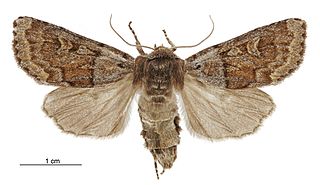
Ichneutica marmorata is a moth of the family Noctuidae. This species is endemic to New Zealand can can be found in the North Island at the Tongariro National Park and at Puketitiri near the Kaweka Range. In the South Island it is widespread. It prefers alpine to subalpine habitat but occurs down to sea level altitudes in more southern locations. Adults are on the wing from late October to February. Larvae of this species may use tussock grasses in the genus Chionochloa as their host and they have been reared on Festuca novae-zelandiae.
Ichneutica haedifrontella is a moth of the family Noctuidae. This species is endemic to New Zealand. It is only known from scattered areas in the North and South Islands. In the North Island it has only been collected in the Pouakai Range in Taranaki. In the South Island it is known from the Nelson, Buller, North Canterbury, Otago Lakes and Fiordland regions. It inhabits alpine to subalpine zones. The life history of this species is unknown as are the host species of its larvae in the wild. Larvae have been reared on species in the Chionochloa genus. Adults are on the wing from December to February and are attracted to light. This species has a smaller dwarf form that can be found in the Pouakai Range and at Dart Hut.
Ichneutica supersulcana is a moth of the family Noctuidae. This species is endemic to New Zealand and is only known from the Tararua Ranges and at Tongariro National Park. This species has been collected in subalpine tussock grasslands as well as subalpine shrubland and at the margins of Fuscospora cliffortioides forest. The life history of this species is unknown as are the host species of its larvae. The adults of this species are on the wing in February and are attracted to light. It appears to be restricted to higher altitudes in comparison to its close relative I. sulcana.I. sulcana and I. supersulcana are very similar in appearance with no reliable visible differences between the two having been discovered. However, there are distinct differences in the male abdomen and genitalia of these two species.
















